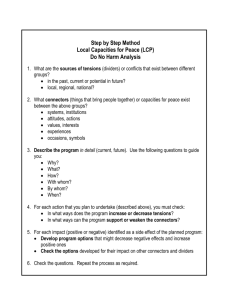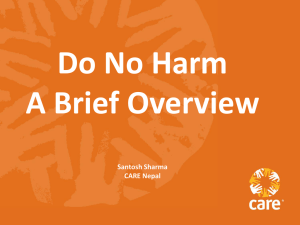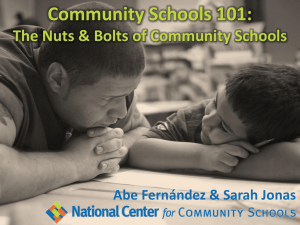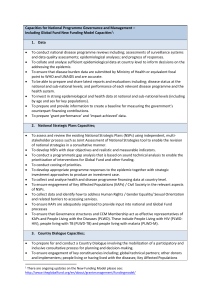Do no harm - ceecis.org
advertisement
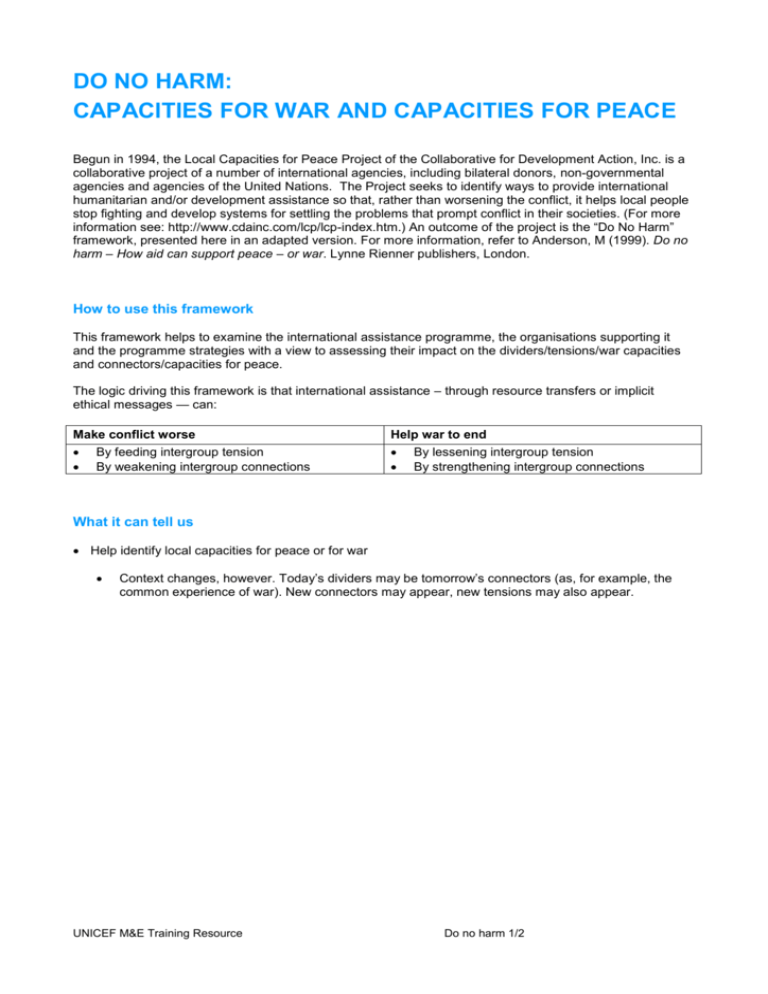
DO NO HARM: CAPACITIES FOR WAR AND CAPACITIES FOR PEACE Begun in 1994, the Local Capacities for Peace Project of the Collaborative for Development Action, Inc. is a collaborative project of a number of international agencies, including bilateral donors, non-governmental agencies and agencies of the United Nations. The Project seeks to identify ways to provide international humanitarian and/or development assistance so that, rather than worsening the conflict, it helps local people stop fighting and develop systems for settling the problems that prompt conflict in their societies. (For more information see: http://www.cdainc.com/lcp/lcp-index.htm.) An outcome of the project is the “Do No Harm” framework, presented here in an adapted version. For more information, refer to Anderson, M (1999). Do no harm – How aid can support peace – or war. Lynne Rienner publishers, London. How to use this framework This framework helps to examine the international assistance programme, the organisations supporting it and the programme strategies with a view to assessing their impact on the dividers/tensions/war capacities and connectors/capacities for peace. The logic driving this framework is that international assistance – through resource transfers or implicit ethical messages — can: Make conflict worse By feeding intergroup tension By weakening intergroup connections Help war to end By lessening intergroup tension By strengthening intergroup connections What it can tell us Help identify local capacities for peace or for war Context changes, however. Today’s dividers may be tomorrow’s connectors (as, for example, the common experience of war). New connectors may appear, new tensions may also appear. UNICEF M&E Training Resource Do no harm 1/2 ASSESSMENT QUESTIONS The following tables outline some considerations that help identify local capacities for peace or for war. Dividers, Tensions, Capacities for War Assessment questions Categories Notes Not only must aid workers identify dividers, tensions, and capacities for war, but also assess their importance. Root or proximate cause Broad-based or narrow involvement of people Internal to society or externally induced Attitudes/actions Values/interests In assessing dividers and tensions (e.g. prejudice, exclusion, struggle for control of disputed resources, political differences), one should differentiate between those arising from injustice or historical inequalities and those that have been manipulated (e.g. by leaders) or that result from the conflict itself. Not all sources of tension or division in societies have the same potential for damage. Some are local or matter to a limited number of people, while others reach across society and involve virtually everyone. Some tensions may actually connect people (e.g. common experience of lawlessness may motivate people to reconnect against the threat). Some dividers and tensions exist within societies, other may be prompted and promoted from outside. The location of the source of conflict must be considered when assessing the potential of aid (e.g. in regional conflicts). Who is divided? Between or among which groups do the tensions or divisions exist? How deeply are people committed to their conflict? How widely is a commitment shared? Who gains from the continuation of conflict, and how widely shared are the gains? Connectors, Capacities for Peace Assessment questions Categories Notes To identify genuine connectors and local capacities for peace in any specific location requires attentiveness to the actual system, actions and interactions in that setting. Longstanding, historical or new As a result of conflict Broad-based, inclusive or narrow, opening wedge Internal or external Actual, existing or potential Attitudes/actions Values/interests Dividers and tensions may be overt and obvious; few connectors or capacities for peace are as readily apparent to aid workers. It is insufficient to identify typical groupings that might be connectors (e.g. elders, women’s groups or schools). Although in some settings they may bring people together, in many societies they promote hatred and reinforce divisions. Experience shows that people with longstanding knowledge of an area may not be in the best position to identify connectors and capacities for peace. People who “know too much” often become mired in the complexities and lack sufficient distance to see opportunities at the local/grassroots level. In what areas are connectors and capacities for peace important? Where do people maintain overt contact and connections across fighting lines? Where do people stay connected in less obvious ways? How widespread or limited are both the overt and the less obvious interactions? Adapted from Anderson, M (1999). Do no harm – How aid can support peace – or war. Lynne Rienner publishers, London. LINK TO EXPANDED VCA The expanded VCA framework (see core content sheet “Expanded Vulnerability/Capacity Analysis”) presents a matrix for analysing a population’s capacity for survival, protection, development. In complex emergencies, where conflict exists, any analysis of capacities in relation to humanitarian objectives must be placed in context of capacities for peace and war; so, too, when analysing stakeholders and their interests. Analysis using the “do no harm” framework, should serve as a background and reference. UNICEF M&E Training Resource Do no harm 2/2
